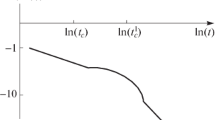Abstract
The capture of particles diffusing anomalously in accordance with a power law in absorbing traps is analyzed in the effective medium approximation. A new slower power-law dependence of the asymptotic form of the particle survival probability over long times has been established. This result is due to the anomalous diffusion of particles in strongly anisotropic media.
Similar content being viewed by others
Change history
02 December 2020
erratum
REFERENCES
A. A. Ovchinnikov and A. A. Belyi, Teor. Eksp. Khim. 2, 405 (1966).
G. V. Ryazanov, Sov. J. Theor. Math. Phys. 10, 181 (1972).
I. M. Lifshits, Sov. Phys. Usp. 7, 549 (1964).
E. W. Montroll and G. H. Weiss, J. Math. Phys. 6, 167 (1965).
J. Klafter and I. M. Sokolov, First Steps in Random Walks (Oxford Univ. Press, Oxford, 2011).
F. Benitez, C. Duclut, H. Chaté, et al., Phys. Rev. Lett. 117, 100601 (2016).
Sang Bub Lee, In Chan Kim, C. A. Miller, and S. Torquato, Phys. Rev. B 39, 11833 (1989).
I. Fouxon and M. Holzner, Phys. Rev. E 94, 022132 (2016).
V. V. Uchaikin, J. Exp. Theor. Phys. 97, 810 (2003).
R. Metzler and J. Klafter, Adv. Chem. Phys. 116, 223 (2001).
J. Klafter and R. Metzler, Phys. Rep. 339, 1 (2000).
Applications of Fractional Calculus in Physics, Ed. by R. Hilfer (World Science, Singapore, 2000), p. 1.
G. Weiss and S. Havlin, Phys. A (Amsterdam, Neth.) 134, 474 (1986).
V. E. Arkhincheev and E. M. Baskin, Zh. Eksp. Teor. Fiz. 97, 810 (1991).
V. E. Arkhincheev, Phys. A (Amsterdam, Neth.) 307, 131 (2002).
V. E. Arkhincheev, Chaos 17, 043102 (2007).
Ya. B. Zel’dovich and A. D. Myshkis, Elements of Mathematical Physics (Nauka, Moscow, 1973) [in Russian].
V. E. Arkhincheev, JETP Lett. 52, 399 (1990).
S. Samko, A. Kilbas, and O. Marichev, Fractional Integrals and Derivatives: Theory and Its Applications (Gordon and Breach, New York, 1993).
G. J. Lapeyre and M. Dentz, Phys. Chem. Chem. Phys. 19, 29 (2017). https://doi.org/10.1039/C7CP02971C
V. E. Arkhincheev, Sci. Rep. 9, 15269 (2019). https://doi.org/10.1038/s41598-019-51362-y
Author information
Authors and Affiliations
Corresponding author
Additional information
Translated by N. Wadhwa
Derivation of the Fractional-Order Equation in the Comb Model
Derivation of the Fractional-Order Equation in the Comb Model
Let us briefly recall the comb model. This model was introduced for the first time for describing subdiffusion on percolation clusters [13]. This model includes a conducting axis (analog of the skeleton of percolation clusters) and reflects the main feature of random walks in inhomogeneous media (anomalous behavior).
Diffusion along the x axis in the comb model is possible only for y = 0. This means that diffusion coefficient Dxx differs from zero only for y = 0 [14, 15]:
i.e., the x component of the diffusion current is given by
Diffusion along the fingers of the comb structure is of conventional type (Dyy = D2).
Consequently, random walks over the comb structure are described by diffusion tensor
Using Fick’s law Jd = –\(\hat {D}\)∇N for the diffusion current with diffusion tensor (A.3), we obtain the diffusion equation.
Further, we perform the Laplace transformation in time and the Fourier transformation in the x coordinate:
Here, G(s, k, y) is the Green function with initial conditions in the form of point source δ(x)δ(y)δ(t). We will seek the expression for the Green function in form
Substituting this expression into Eq. (A.4), we obtain the regular equation and the equation with singular part δ(y):
This gives the fractional-order effective diffusion equation for random walks along the backbone axis of the comb structure:
Rights and permissions
About this article
Cite this article
Arkhincheev, V.E. Temporal Asymptotic Form of the Survival Probability in the Effective Medium Approximation for Trapping of Particles in Media with Anomalous Diffusion. J. Exp. Theor. Phys. 131, 280–283 (2020). https://doi.org/10.1134/S1063776120060102
Received:
Revised:
Accepted:
Published:
Issue Date:
DOI: https://doi.org/10.1134/S1063776120060102





